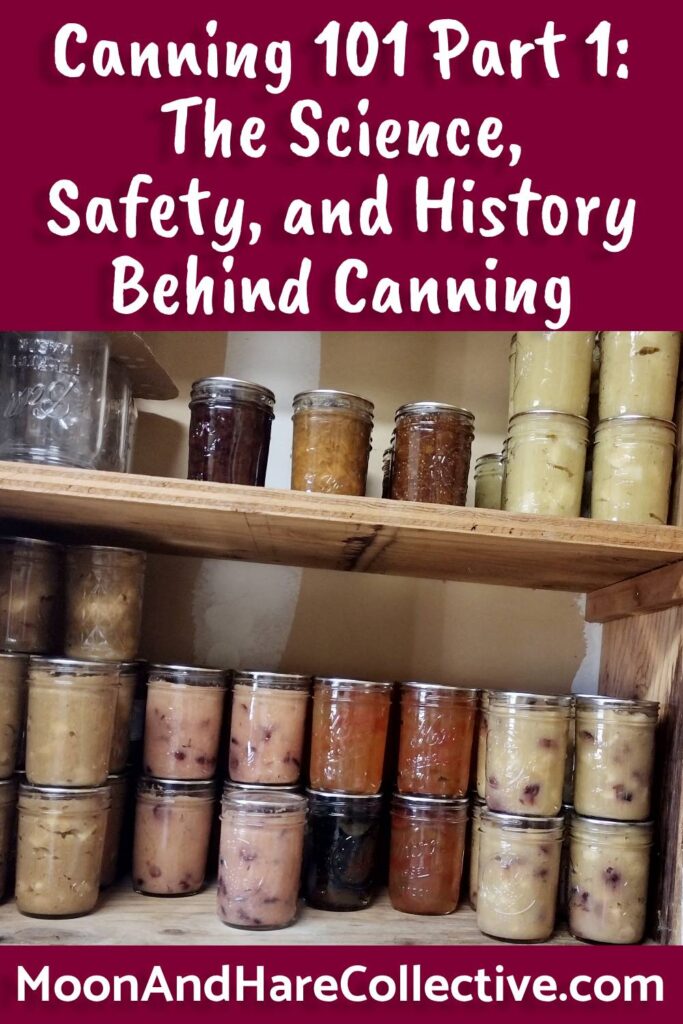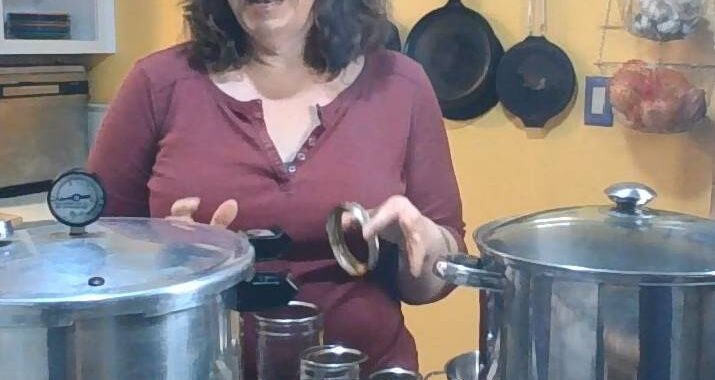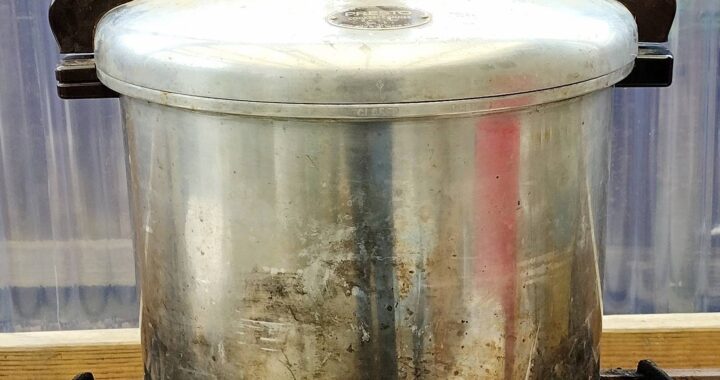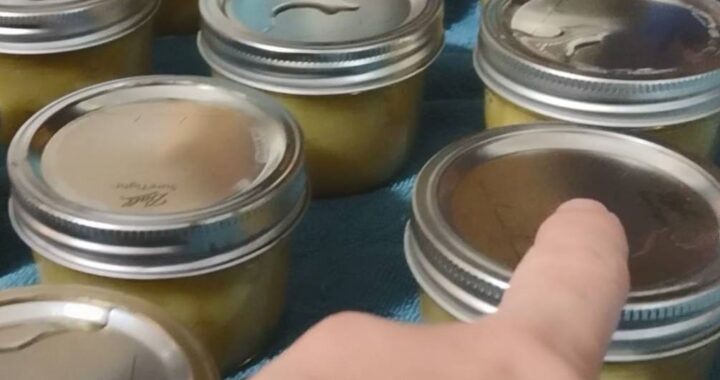Are you ready to start your canning adventure? Waterbath and pressure canning are fun and useful ways to preserve the harvest from your garden, or great deals that you may get on bulk produce. This is such a great way to stock your pantry and also to know what you’re feeding your family all through the year!
This video is part 1 of a 4 part series all about canning! This episode covers the history and science behind canning and why they show us how to be safe when preserving our food. Next, we’ll dig into the specifics of waterbath canning and pressure canning, then finally, I’ll answer the questions you have about both types of canning. Sign up for my newsletter below the video so you’ll get notified when fresh homesteading and homemaking content is released! Also- the transcript is available below the video as well!
My Favorite Books About Canning:
– Ball Complete Book of Home Preserving
– Food in Jars: Preserving in Small Batches Year-Round
– Preserving by the Pint: Quick Seasonal Canning for Small Spaces from the author of Food in Jar
– Well Preserved: Small Batch Preserving for the New Cook
– The Complete Guide to Pressure Canning: Everything You Need to Know to Can Meats, Vegetables, Meals in a Jar, and More
– The Complete Book of Small-Batch Preserving: Over 300 Recipes to Use Year-Round
– WECK Small-Batch Preserving: Year-Round Recipes for Canning, Fermenting, Pickling, and More
Some Great Links for Canning Recipes:
These are links with trustworthy and reliable home canning recipes!
Ball Mason Jars
National Center for Home Food Preservation
USDA’s Complete Guide to Home Canning
Food in Jars
Simply Canning
Bernardin Canning Jars & Recipes
Further Reading
To learn more about the history and science behind canning – check out these links:
– Britannica. Canning. https://www.britannica.com/topic/canning-food-processing
– USDA. How Did We Can? The Evolution of Home Canning Practices. https://www.nal.usda.gov/exhibits/ipd/canning/timeline-table
– International Food Additives Council. From Appert to the Ball Brothers: a history of canning. https://www.foodingredientfacts.org/apperttotheballbrothers/
– University of California: Agriculture and Natural Resources. UC Master Food Preserver Program of Orange County. Botulism. https://ucanr.edu/sites/MFPOC/Emergency/Botulism/
Keep scrolling to find the transcript!


Transcript:
Welcome to Canning 101: The Science, History, and Safety Behind Preserving Your Harvest
Canning is a really great way to preserve the harvest from your garden. There are two different types of canning – water bath and pressure canning. They’re used for different types of foods and there are some really important reasons for that. Today, I’ll cover the differences between water bath and pressure canning and the types of foods that can be canned with each type. I also want to cover the history and the science behind canning – both of which help inform us why we use each type of canning for different foods and show how important it is to be safe when canning.
This is the first in a four part series all about the basics of canning. Check my channel for the next videos!
First, let me introduce myself!
I’m Chrissy Bernards, the owner of Moon and Hare Collective and Urban Farm here in Oregon. I am an urban agriculture and homesteading educator, a curriculum developer, and a community herbalist. I grew up on a vegetable farm, where I learned how to can and preserve food, and eat seasonally, along with sewing and other DIY skills. I ran away from the farming lifestyle as soon as I could, but after several years, I felt the pull back to growing food and traditional homemaking. I now use permaculture and regenerative growing methods on my urban homestead, where I teach about urban agriculture, food preservation, cooking on a budget, seasonal living, and other homesteading skills as a medium to introduce people to food systems and sustainability issues. I always love to know the science and history behind the techniques that we use to preserve food, so I understand the safety and reliability of the process. Then I know which rules are ok to bend or even to break!Make sure you subscribe to my newsletter at the link in the description so you’ll get notified when I put out more videos with valuable homesteading and homemaking information!Ok, let’s dig in and get started!
Alright, here we have the two different types of canners
– a pressure canner, and a really big stock pot for waterbath canning. Yes, you can use almost any pot you have around for waterbath canning. I’ll get into that in a future video though. You can also use your pressure canner as a waterbath canner if you want to save on space.
Waterbath canners work by submerging jars into this vat full of water, and bringing it to a boil for the right amount of time.
Pressure canning is done by locking the jars in the pot, and raising the pressure inside with heat, for the correct amount of time. There is water inside- just about a quart, which is used more like a signal to tell when all the air has been pushed out of the canner.
Waterbath canning is for high acid fruits, like apples, strawberries, and the like. You can also add acid to some low acid foods and then they can be waterbathed as well – some examples of that are pickles, which use vinegar to raise the acid.
Pressure canning is for low acid produce like green beans and corn. You can also pressure can broths, meat, or dry beans.
Ok, let’s talk about the history of canning, and why that’s important to keep in mind for the safety of canning.
Now, most homesteading activities started in the home and then were taken and commercialized to create the versions you find in the store. Think about curing meat, baking bread, fermenting foods like sauerkraut and yogurt. These all started in the home and have been done for millenia, so we have a really long history of knowing which methods work and that they’re safe.
Canning, on the other hand, did not get its start in the home. Canning started as a commercialized process and THEN a version was created for home canners.
In 1795, Napoleon created a contest for preserving food in an economical manner that could be transported safely with his armies. In 1809, the award was won by a man named Nicholas Appert, who created the first canning process. But even he didn’t understand how it worked! It would be more than 50 years later that Louis Pasteur discovered how canning kills and deactivates microorganisms that would otherwise make the food spoil.
It wasn’t until the 1880s that canning became available to the public, and it wasn’t until around 1910-1915 that canning was widely available. Really the 1930s and 40s were the high point of canning.
It’s also important to note that while canning started gaining popularity around 1910 – there were so many deaths and illnesses from botulism poisoning, that in 1917, the USDA stated that low acid foods should be pressure canned only.
Why is all this history stuff important?
Those other household processes – baking bread, curing meat, fermenting yogurt… we literally have thousands of years of history of knowing exactly what works, how they work, and how safe they are.
We don’t have that with canning. Canning was invented before we knew how it works, and science and technology have had to catch up in order to explain how it works. We have less than 200 years of knowing how canning works, compared to literal millenia for other food preservation processes.
In fact, since canning was invented as a commercial process first, and THEN introduced to home canners, the science for home canning lags even farther behind because there isn’t the monetary enticement.
In those big factories, they’re using tin cans, not glass jars, and they are able to get foods to higher temperatures and higher pressure in the canners, which allows them to can things that home canners aren’t able to.
In many canning groups, members often share stories of how their ancestors successfully waterbath canned both low-acid AND high-acid foods for generations and generations and generations. However, canning just hasn’t been accessible for as long as some believe. It just hasn’t been widely available for generations and generations and generations. Additionally, once it did become more widely available, experts quickly recommended using pressure canning for low-acid foods due to its recognized safety benefits.
Between the history of canning, and the science behind it, I think you’ll find that it’s just worth it to be safe when canning. Let’s get into the science stuff next!
So, how does canning work? And how does waterbath canning work versus pressure canning?
Canning is a two part process, which includes killing and inhibiting the growth of microorganisms, namely the botulism virus and spores. And then sealing the jar to make sure no more microorganisms get in.
Botulism has 2 forms – the bacteria or vegetative state, and the spores. The bacteria is relatively easy to kill, and having food reach the temperature of boiling – which is 212 degrees fahrenheit or 100 degrees celsius for a certain amount of time – will do it. The amount of time is dependent on the density of the food product. So sauces and jams take a shorter amount of time than something more dense, like pickles or meat.
However, the spores are much harder to kill.
In waterbath canning, we rely on the high acid environment inside the jar to keep the spores from growing. The acid is provided by the produce itself, or vinegar, or sugar, or a combination of these things.
Low acid foods create an ideal environment for the spores to grow, so in this case, we really want to make sure the botulism spores are deactivated. To do this, the food needs to reach a temperature of 250 degrees fahrenheit or 121 degrees Celsius for 20-100 minutes- again, depending on the density of the food product. This can only happen in a pressure canner, where the pressure is raised, allowing the temperature inside the jars to get up to the right temperature. The density of the food matters, because the temperature has to get to 250 degrees all the way to the center.
Technically, you can still find some recipes out there for waterbath canning low acid foods – but they have to be in the waterbath for somewhere between 3 and 10 hours – during which time the water has to completely cover the jars. If the water gets to the top of the jars, you have to add more. And everytime you add more water, the boiling will stop, so you have to to pause the timer until the water comes back to a rolling boil.
So, first of all, that just sounds like a pain. 8 hours of standing over a boiling pot – when the longest it takes to pressure can something is about 2 hours?
And remember, you’re cooking the produce in those jars as well – and cooking them for so long will just turn them to mush.
It’s really best to just use the safe recommendation.
I’ll get into the how-tos of pressure canning in future videos – but I promise that it’s not scary at all.
The second part of canning is the sealing of the jars. In both pressure canning and waterbath canning, when you remove the hot jars from the canner, the heat escaping the jars, causes the lid to compress to the jar, and the rubber seal seals the goodness in and keeps the air and microorganisms out.
Once the jars come out of the canner, we want to place them on a towel on the counter or a table and let them sit just the way they are for 12-18 hours – until they’re completely cool. During this time, you may hear the lids popping as they seal. It gives you a little dopamine hit every time you hear it.
Once the jars are completely cool, remove the rings and see if they’re sealed by tapping the lids. If the lid goes up and down a little, it didn’t seal. Refrigerate and eat within a week or so. If it’s a sauce, broth, or jam, something that won’t be harmed by being cooked longer, go ahead and reprocess it if you like.
Store the filled and sealed jars in a cool dark place until you’re ready to use them! Store them without the rings. Many times when microorganisms grow, or if the food starts to ferment, it will make the lid pop open, and that’s a really good way for you to know NOT to eat it! If you leave the ring on, it’s more likely that it could reseal itself with heat fluctuations, which makes it more likely that you might think it’s ok to eat.
And that’s it!
Now, there are ways to play around with the amount of acid, or rules that can be bent – but in general, I believe both the history and the process of canning shows that we should be using safe and approved methods. Especially, please don’t mess around with canning until you have a lot of experience with safe methods under your belt. I’ll provide links to some of the best websites and books with canning recipes in the post for this video. Make sure you head over to my website to take a look!
So, canning is a great way to save your garden’s harvest, blending science, history, and tradition. By learning the differences between water bath and pressure canning, and understanding their backstory, you can make sure your preservation efforts are both effective and safe. Stay tuned for the next video, where we’ll dive into using a water bath canner. I’ll keep adding more videos about homesteading and homemaking, so make sure to subscribe to my youtube and my newsletter so you’ll get all the fresh posts!



